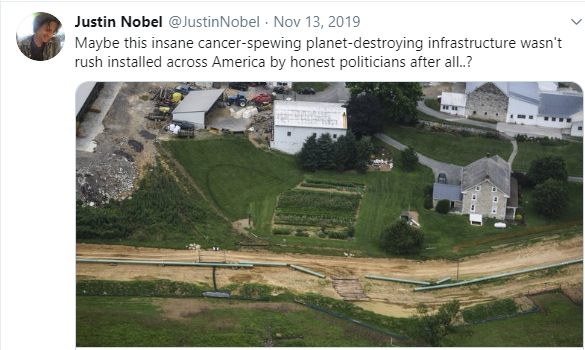Rolling Stone ignores science, facts in latest piece that further questions outlet’s journalistic credibility

Amid declining readership, Rolling Stone, the once iconic magazine that’s now “a shell of its former self,” continues to advance one-sided, deeply biased articles attacking American energy development.
Its latest article, by author Justin Nobel, the “infamously left-leaning magazine” that’s lost its “journalistic credibility,” sets independent science, well-known facts, and years of data aside to peddle speculation and one-sided fear tactics. One look at Mr. Nobel’s Twitter – where he recently referred to energy infrastructure as “insane cancer-spewing planet destroying” projects – and his bias against safe, job-creating natural gas development is abundantly clear.
What’s more, Rolling Stone’s latest is funded by the Institute for Policy Studies, a “progressive think tank” that has called the use of safe, responsible hydraulic fracturing a “disaster.” It receives support from other well-known foundations who describe the technology that’s enabled America to reduce its carbon emissions more than any other country as a “threat.”
***MSC Fact Checks Rolling Stone’s Journalism***
Biased, Pandering Rolling Stone Blog Misses Mark…Again
Stick to Music, Rolling Stone
For Mr. Nobel, and the foundations that fund his work, the goal is not to call the balls and strikes fairly – as we expect respected, professional journalists to do – but to deploy scare tactics, false information, and deeply biased reporting to ban oil and natural gas development.
While the reporter spent nearly two years “investigating” radiation and shale development, the topic has been well-studied and the facts are clear, straightforward.
Here’s what you need to know:
- What Is Naturally Occurring Radioactive Material (NORM) and Technologically Enhanced Radioactive Material (TENORM)?: NORM and TENORM refers to the radioactivity present in everywhere in the environment. From the food we eat to countertops in our kitchens, humans are exposed to some level of harmless radiation throughout the course of everyday life.
- What are Normal Exposure Levels?: The average American receives approximately 620 millirems (mrems) each year of NORM and TENORM sources, according to the Nuclear Regulatory Commission (NRC). The agency affirms that has not been shown to cause humans any harm. Through various activities, like a cross-country flight (5 mrems) or a living in a brick house (7 mrems), humans are exposed to background radiation. As the chart demonstrates, the estimated annual exposure for a truck driver in the oil and gas industry, for example, is less than 1 mrems.

- Are Oil and Natural Gas Workers or the General Public at Risk?: In January 2015, the Pennsylvania Department of Environmental Protection released the results of an in-depth two-year study which found “there is little potential for harm to workers or the public from radiation exposure due to oil and gas development”. (Pa. DEP, 1/15/15)
- What is the Industry doing to manage the risks from TENORM?: The oil and gas industry characterizes and profiles waste materials for ultimate disposal at appropriate permitted facilities. While the majority of waste streams generated by the oil and gas industry do not pose a risk to workers or the general public, industry professionals are able to make proper adjustments to handling, processing, and disposal protocols based on screening, monitoring, and analytical data.
The MSC supports its members’ compliance with regulatory requirements and recommended management practices for NORM and TENORM. These waste materials must be handled, stored and disposed of in compliance with regulations that ensure the safety of workers and the public. Appropriate member company personnel are trained on NORM protection, proper handling and proper disposal of NORM and TENORM containing waste. All potential NORM exposures to workers and members of the public from TENORM are either eliminated or reduced to levels that are well below acceptable radiation protection standards. In Pennsylvania, depending on predicted radiation dose levels from TENORM waste, additional protective actions may include:- Sampling waste and determining radionuclide levels, using these to determine proper protection and disposal;
- Monitoring truckloads of waste when it leaves the well site and when it arrives at a landfill;
- Performing work area surveys to determine radiation exposure levels;
- Performing contamination surveys of personnel and equipment prior to leaving work areas;
- Segregating TENORM to a holding area to limit exposures; and
- Preparing and implementing a radiation action plan.
For more facts and information regarding NORM and TENORM click here.




